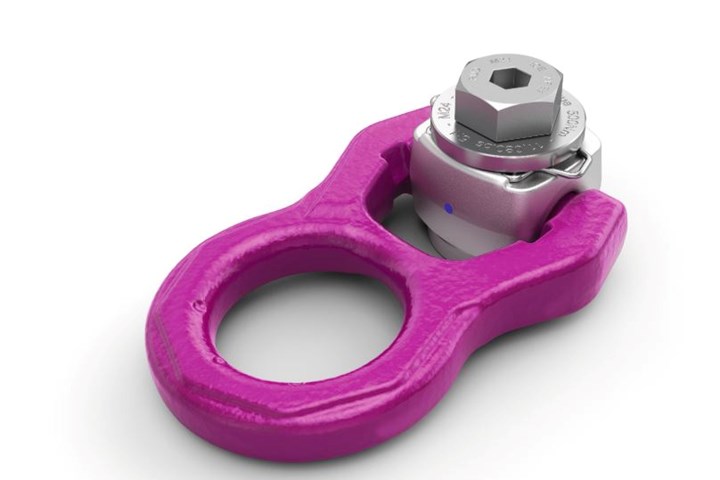Hoist Ring Prevents Damage and Increases Load Capacity
RUD Ketten, Rieger & Dietz GmbH u. Co. KG presents a hoist ring with a spring mechanism to ensure the anchor point turns in the load direction while raising, removing bracket damage from large shear forces and bending or breakage from sudden bracket turns.

Photo Credit: RUD Ketten, Rieger & Dietz GmbH u. Co. KG
RUD Ketten, Rieger & Dietz GmbH u. Co. KG presents a hoist ring with a spring mechanism to ensure the anchor point turns in the load direction while raising, removing bracket damage from large shear forces and bending or breakage from sudden bracket turns. The spring also prevents a bracket 90-degree position and moves it in the direction of the optimal force transfer during lifting, avoiding a sudden dropping of the load.
In addition, the hoist ring’s round bracket design achieves a secure and reliable sit for the hook, providing optimal force transfer and preventing component damage or tilting of the hook. It utilizes screw technology that combines maximum strength with high toughness to withstand high statically and dynamically bending loads. Additionally, the anchor point is reinforced at locations most exposed to loads, increasing load capacities as high as 30% compared to comparable sizes.
The hoist ring also offers abrasion lenses to determine whether the anchor point has reached discard criteria, as well as an undetachable but changeable combi-head screw for easy handling. It is available with screw diameters of ½", 5/8", ¾", 1" and 1¼", and it will suit engineering, tool construction, the automotive and plastics industries and energy sector companies.
An RFID transponder is installed as standard to simplify operating equipment inspection, enabling the anchor point to be identified by a factory-set ID number transferable by laptop or mobile device to corresponding software tools. Users can manage test data and documents either in their own databases or through a cloud-based resource management tool. This reduces inspection costs and times and leads to more process reliability.
Related Content
-
6 Ways to Optimize High-Feed Milling
High-feed milling can significantly outweigh potential reliability challenges. Consider these six strategies in order to make high-feed milling successful for your business.
-
Hands-on Workshop Teaches Mold Maintenance Process
Intensive workshop teaches the process of mold maintenance to help put an end to the firefighting culture of many toolrooms.
-
Solving Mold Alignment Problems with the Right Alignment Lock
Correct alignment lock selection can reduce maintenance costs and molding downtime, as well as increase part quality over the mold’s entire life.





.jpg;maxWidth=300;quality=90)






